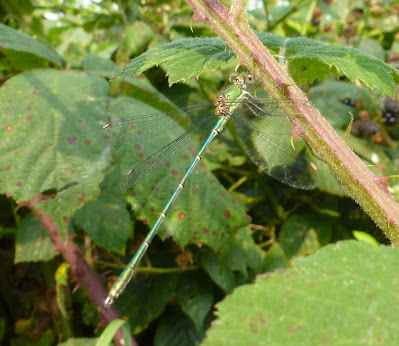As we gathered in NWT’s Hickling Broad and Marshes nature reserve’s car park, the talk was on a strange subject, namely galls on alder catkins. This was prompted by two things: alders in the car park, and photos in the printed holiday report I passed to Ann, which included alder catkins with galls that she’d found in Bulgaria’s Western Rhodopes, in that case on grey or speckled alder Alnus incana rather than our common alder, Alnus glutinosa. More on these later.
The introductory chat with Rachel at the visitor centre was punctuated by observing a black-tailed skimmer on the ground and hornets going into the centre’s roof. We started by failing to find a wasp spider in the long grass, which was a star find on the Honeyguide group’s visit this time last year, on 24 August 2023.
 |
| Ruddy darter. |
Twice willow emerald damselflies landed and posed for us. Other species today were blue-tailed and common blue damselflies.
 |
| Willow emerald damselfly. |
Much of the interest today was in various invertebrates. Three of these (a fourth, Roesel's bush-cricket, jumped too quickly for a photo) are in the photo collage below: dingy footman, green shield bug and the chrysalis of a drinker moth, which – from the hole on the side of the pupa’s case – had either been parasitised or predated.
 |
| Top: green shield bug and dingy footman moth. Bottom: drinker moth chrysalis and female black-tailed skimmer. |
Birds in the reedbed area were fairly quiet, as you might expect in August: distant calling cranes, a chew chew of a greenshank, Cetti’s warbler, glimpses of bearded tit. But it paid to look up from time to time, such us twice when a spoonbill flew past, and for that other big white bird now regular at Hickling, great white egret.
Ah yes, those galls on female alder catkins, which are caused by the ascomycete fungus Taphrina alni. The best place for these, we found, was on alders by the viewpoint over Hickling Broad, where we’d stopped to see the usual great crested grebes and herd of mute swans. There were at least 10 of these galls here, plus a few later, and the photo collage gives a feel for the variation in size, colour and shape, all in a range of tongue-like shapes.
 |
| Galls on female alder catkins, caused by the fungus Taphrina alni. |
In late summer and early autumn, we all instinctively turn over oak leaves to look for galls. It’s interesting how the number of these vary from year to year. As well as many common spangle galls, what caught the eye this year were egg-shaped galls on the veins of oak leaves caused by the gall wasp Neuroterus anthracinus. Some were green, others 'ripening' to red and turning blotchy.
 |
| Galls on oak leaves caused by the gall wasp Neuroterus anthracinus. |
It was too late in the year to see the rare fen mason wasp, though we did look closely at patches on the ground that had been fenced to protect them. We found one distinct ‘chimney’ or ‘turret’ from an underground nest. Back at the visitor centre, warden John Blackburn was saying that the soil pellets discarded by burrowing females are equally distinctive and therefore a good indicator of the wasps' presence: these are also evident in the photo.
 |
| Fen mason wasp ‘turret’. |
Farther round there were three freshly emerged small tortoiseshell butterflies on hemp agrimony. Gatekeepers were also fairly numerous.
 |
| Small tortoiseshell on hemp agrimony. |
Even creeping thistle had two points of interest. The swelling on the stem is a gall caused by the picture-winged fly Urophora cardui. The creamy-white foliage is explained by this quote: "This is caused by Pseudomonas syringae, a bacteria that produces a chemical called tagetitoxin, which poison chloroplasts and causes chlorosis."
 |
| Creeping thistle: gall and bleaching caused by a bacterium. |
Brendan’s Marsh was relatively quiet here, though we returned to look over it from the other side after we’d had our picnic lunches. From the viewing platform it was easy to find two nests of spoonbills: this species is nesting at Hickling for a second year. There were also two spoonbills on Brendan’s Marsh, at least three great white egrets and several little egrets. These were mixed in with many geese (Canada, greylag and Egyptian), ducks in eclipse plumage, namely mallard, gadwall, shoveler and teal, lapwings and a single ruff.
 |
| Spoonbill collage of digiscoped images:two on Brendan's Marsh and distant nest. |
 |
| Brendan's Marsh: great and little egrets and various wildfowl (digiscoped). |
Back in the car park, now we’d got our eye in for them, we found a few more galls on the alder catkins over our parked cars, which we showed to Rachel. Perhaps not as showy for sharing with visitors as last year’s wasp spider, but certainly a point of interest.
Chris Durdin




This event raised £125 for Norfolk Wildlife Trust.
ReplyDelete